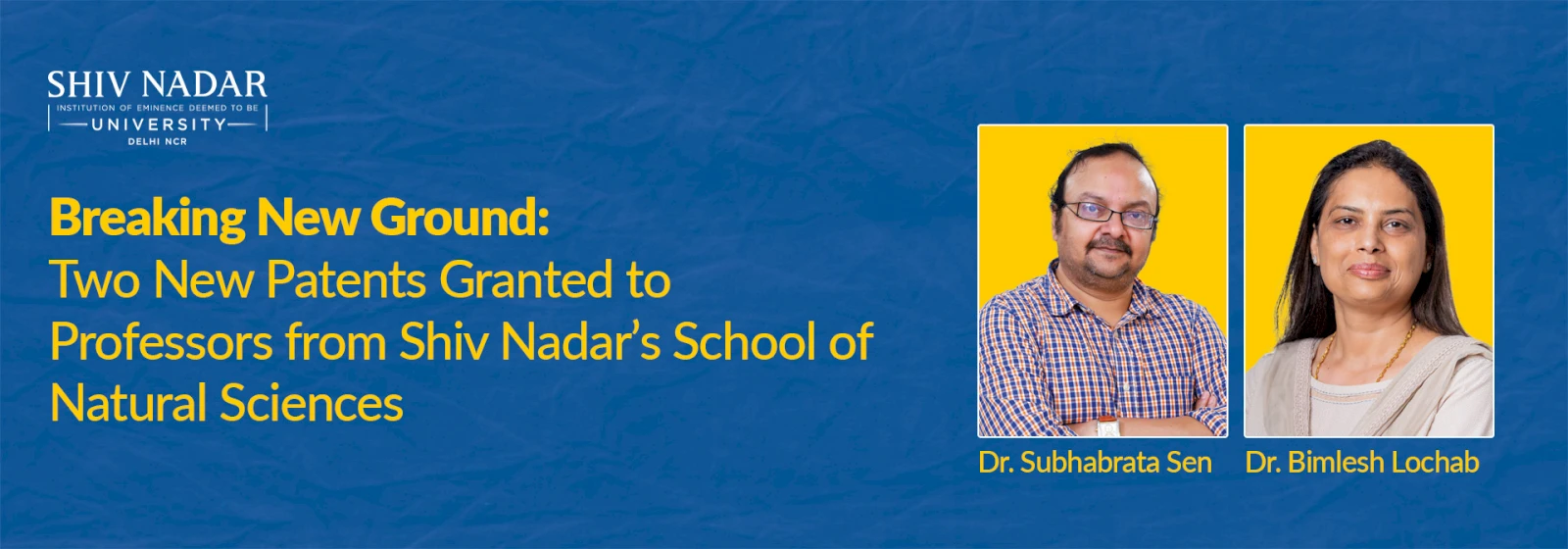Breaking New Ground: Two New Patents Granted to Professors from Shiv Nadar’s School of Natural Sciences
The concept of interdisciplinary research is well-known at the School of Natural Sciences, Shiv Nadar Institution of Eminence (SNIoE). Its dynamic, leading-edge research environment is best evidenced by the growing number of patents granted to the work done here. Anyone remotely familiar with obtaining a patent in India knows how the research's uniqueness and applicability must be demonstrated before the patent is issued. In an impressive display, two professors from the Department of Chemistry have been granted patents for their research this year.
First, Dr Bimlesh Lochab and team were awarded a patent for the ‘Process of preparing oxazine-ring substituted benzoxazine.’ The patent relates to the preparation of a certain class of polymers named polybenzoxazines. These polymers have a long shelf life and minimal shrinkage during polymerisation. Combined with their excellent thermal and mechanical properties and chemical and water resistance, these high-performance polymers are frequently used to make fibre-reinforced composites, adhesives, and laminates in printed circuit boards. The present research focuses on altering the properties of polybenzoxazines by modifying their individual (monomeric) units, such as benzoxazine. These benzoxazine monomers contain a structure called an oxazine ring, which provides fertile ground for tweaking the architecture of the resulting polybenzoxazine polymer. By adjusting the positioning of the oxazine ring or by substituting functional groups, such as alkyls, halides, nitriles, etc., into the ring, new and innovative structures for benzoxazine monomers can be developed.
Dr Lochab and team first systematically compared oxazine-ring substituted benzoxazine monomers with unsubstituted benzoxazine in terms of their thermal properties and stability. They characterised the structures of these synthesised monomers using a variety of techniques, including nuclear magnetic resonance (NMR) spectroscopy, high-resolution mass spectrometry (HRMS), and X-ray diffraction (XRD). Differential scanning calorimetry (DSC), Fourier transform infrared (FTIR) spectroscopy, and gas chromatography-mass spectrometry supported how and at what temperature these units join together to form polymers. These polymers are highly thermally stable. In general, monomer polymerisation of this class demands high temperature and consequently huge mass loss due to evaporation—which is a big challenge. Ideally, 100% mass utilisation is desired: what is added should polymerise efficiently.
Overall, they found that structural designing and substitutions at the oxazine ring's 2- and/or 4- positions overcome these challenges. These findings led them to conclude that selectively positioning functional groups into the oxazine ring of benzoxazine monomers can be a first step towards tuning and designing polybenzoxazines for a wide range of applications.
They followed up this research by developing a method for synthesising thiophene-based oxazine-ring substituted benzoxazine monomers and polymers. Dr Lochab describes the research, “The newly developed synthesis has unique advantages in that it is catalyst-free, scalable, and can be performed using commercially available (sustainable) reactants. My team also investigated the structure and stereo-electronic properties of the developed benzoxazines, and a way forward to modulate properties at the (macro)molecular level is via optimisation of intramolecular interactions.” Moreover, the benzoxazines synthesised using this method had exceptionally high thermal performance, indicating that this direction of research is ripe for developing tailored, high-performance polybenzoxazines with potential smart applications. All in all, this patent and its associated research is a considerable step forward in the field of designing this new, highly useful latest class of polybenzoxazines through oxazine-ring substituted monomers.
The second patent was granted to Dr. Subhabrata Sen for ‘Therapeutic novel chemical entities and method thereof’ to develop and synthesise drug compounds that can potentially treat COVID-19.
While vaccines have done a great job towards preventing or lessening the impact of COVID-19 infections, there still remain only a few therapies for the treatment of the active disease. Most compounds presently used to treat COVID-19 are repurposed drugs originally developed to treat other diseases. Furthermore, these drugs largely target only one of the pathologies of COVID-19.
In their research, Dr Sen and team developed a library of novel indolealkylamines (IAAs) as multi-target drug candidates that can impact several molecular targets involved in COVID-19. The novel IAA compounds developed by the team were extensively characterised and validated for their interactions with melatonin receptors, ACE2 (the entry point into cells for SARS-CoV-2, which causes COVID-19), calmodulin (a major intracellular calcium receptor), and Mpro (a key enzyme involved in the replication of SARS-CoV-2). Two of the synthesised compounds, in particular, showed the ability to inhibit the entry of SARS-CoV-2 into host cells and decrease their replication activities. This makes them highly promising as drug candidates for the treatment of COVID-19. Speaking of the research, Dr. Sen says, “Further fine-tuning of these compounds could provide novel therapeutics for the treatment of COVID-19 and other coronavirus diseases. Additionally, this research serves as strong proof-of-concept for the design of multi-target drugs using an IAA scaffold.”
While these two patents are evidence of the stellar research performed at SNIoE this year, they are not the full extent of the institute’s achievements. A total of 15 other patents have been filed by the Department of Chemistry this year, as well as three patents from the Department of Physics and two patents from the Department of Life Sciences. Transforming research work in labs to the potential new high-performance smart materials to meet society's expanding needs! What a kickstart to this year.
Let us congratulate these extraordinary researchers from the School of Natural Sciences, Shiv Nadar Institution of Eminence, Delhi-NCR, for their marvellous work, outstanding results, and ingenious contributions to their fields, all of which have led to the granting of these patents.
